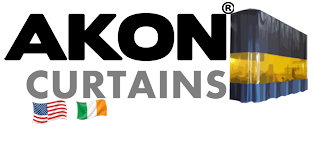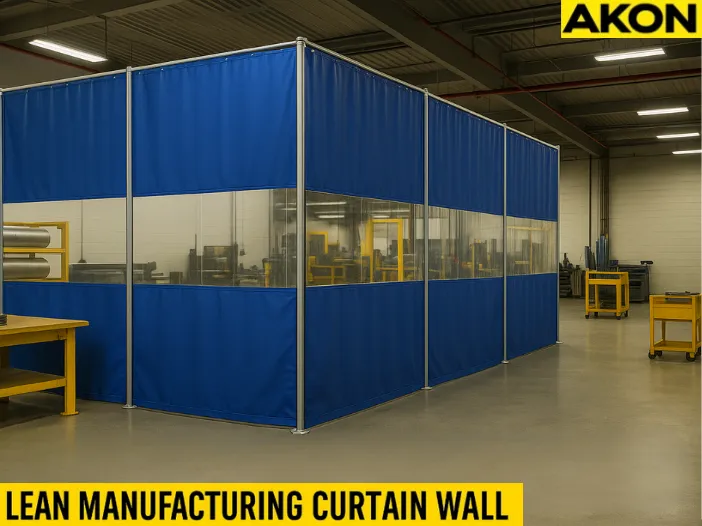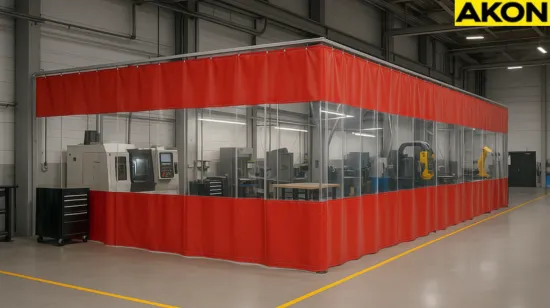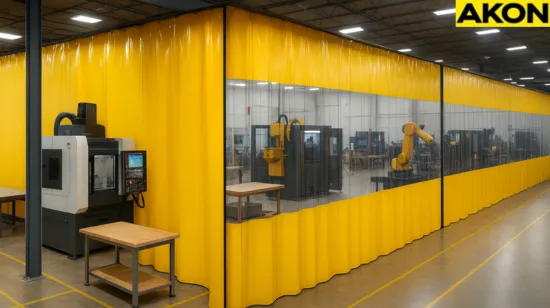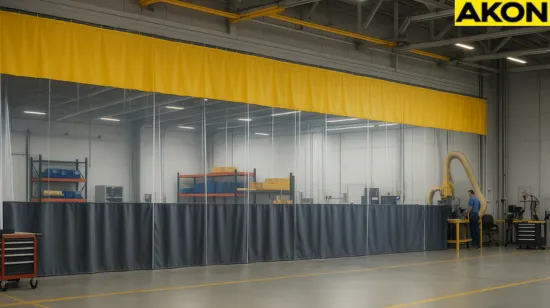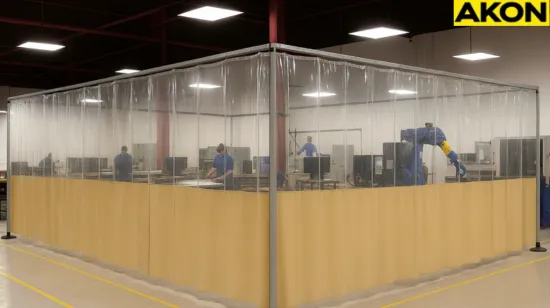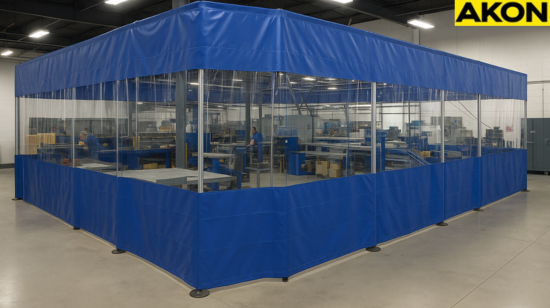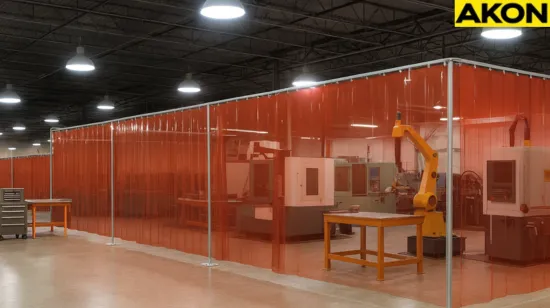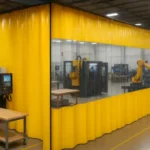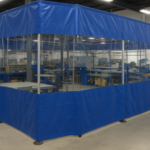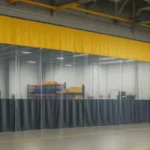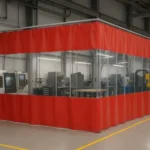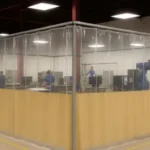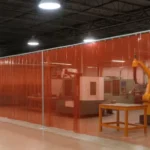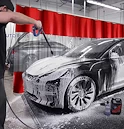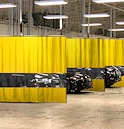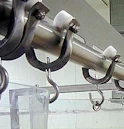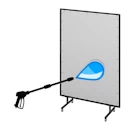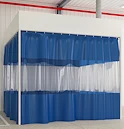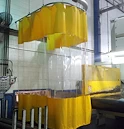Lean manufacturing focuses on cutting waste and improving flow. Curtain walls provide a flexible and cost-effective alternative to permanent walls. In this guide, you’ll learn how curtain walls support lean layouts, steps for setup, product options to consider, common FAQs, and how to take the next step in streamlining your facility.
Why Curtain Walls Support Lean Manufacturing Goals
Lean facilities need tools that evolve with changing demands. Curtain walls make it easier to maintain efficiency without the heavy costs or disruptions of permanent construction. Below, we’ll look at two ways they directly support lean manufacturing:
Operational Efficiency and Cost Savings
Curtain walls allow layouts to shift with production changes, avoiding costly renovations or downtime. Their affordable installation helps businesses free up resources for growth projects and continuous improvements, reinforcing lean principles without straining budgets.
With modular designs, facilities can scale zones up or down without impacting production schedules. This flexibility ensures companies stay agile in responding to new customer demands or market shifts.
Workplace Improvements and Safety Benefits
Beyond efficiency, curtain walls separate zones to manage noise, dust, odors, and temperature more effectively. Built from durable, heavy-duty materials, they also include fire-retardant options that improve compliance and safety, creating a cleaner, healthier environment for employees and equipment.
Safer, quieter work areas also boost worker satisfaction and reduce fatigue. Over time, this leads to higher productivity and fewer workplace disruptions.
How to Create a Lean Curtain-Wall Layout
Turning lean principles into practice doesn’t have to be complicated. By following a few targeted steps, you can set up a curtain wall layout that keeps your facility efficient, adaptable, and ready for continuous improvement.
Action Steps:
• Map your current production flow to spot bottlenecks before making changes.
• Define lean work zones such as assembly, inspection, storage, or welding.
• Select curtain wall materials and hardware designed for each zone’s specific needs.
• Install modular curtain partitions quickly to create boundaries without major construction.
• Review and adjust layouts regularly as lean processes evolve over time.
Flexibility
Reconfigure zones on demand to keep up with workflow changes.
Minimal Disruption
Fast installation means your facility keeps running smoothly.
Space Optimization
Smart zoning maximizes usable floor space and cuts waste.
Visibility & Oversight
Clear partitions give supervisors full view of operations.
Environment Control
Add-ons like insulated panels, air vents, or sound barriers help tailor each area for comfort, quality, and compliance.
Curtain Walls vs. Permanent Walls
When weighing options for lean facility layouts, it helps to see how curtain walls stack up against traditional construction. Below is a clear side-by-side look at the key differences.
| Feature | Curtain Walls | Permanent Walls |
|---|---|---|
| Installation Time | Hours, minimal disruption | Days or weeks, requires major build |
| Cost | About one-third of fixed wall cost | High upfront materials and labor |
| Flexibility | High, reconfigurable and modular | Low, static and costly to change |
| Environmental Control | Excellent for dust, noise, and temperature containment | Limited once built |
| Worker Comfort | Strong, safer and more comfortable zones | Variable, rigid and less adaptable |
| Lean Alignment | Ideal for continuous improvement | Poor, slows adaptability |
While permanent walls can lock you into a single design, curtain walls keep your facility future-ready. By choosing a solution that evolves as fast as your production demands, you protect both your investment and your ability to adapt, two essentials for staying competitive in a lean environment.
Curtain Wall Product Options for Lean Facilities
Once you’ve decided to use curtain walls in your lean layout, the next step is choosing the right material for each zone. Different products serve different needs, whether you’re separating dusty welding areas, keeping assembly lines visible, or protecting workers from UV exposure.
Opaque Vinyl Curtains
For areas where dust, sparks, or noise are common, opaque vinyl is a reliable choice. These heavy-duty curtains keep operations contained while offering long-term durability.
• Heavy-duty vinyl keeps dust, sparks, and noise contained
• Creates private work zones without permanent walls
• Durable enough for long-term industrial use
Clear PVC Curtains
If visibility is key, clear PVC is the most efficient option. Supervisors can maintain oversight while workers still benefit from particle control and natural light.
• Full transparency for easier oversight and communication
• Allows natural light through, cutting down on energy costs
• Contains particles without slowing workflow
Tinted Curtains
Tinted options are designed for UV-sensitive spaces or welding zones. They add a layer of safety while still allowing visibility and diffused light.
• Protects workers and equipment from harmful rays
• Maintains safety compliance in high-risk zones
• Offers visibility with added light diffusion
Frequently Asked Questions About Machine Guarding
FAQs — Create a Lean Manufacturing Layout Using Curtain Walls
How do you create a lean manufacturing layout using curtain walls?
You create a lean layout by installing industrial curtain wall partitions that separate work zones without permanent construction. These modular dividers make it easy to align space with lean manufacturing principles like reducing wasted movement and improving flow.
How fast can you create a lean manufacturing layout using curtain walls?
Vinyl curtain walls install in hours, not weeks. With track-mounted hardware and pre-sized panels, your lean manufacturing layout can often be ready the same day you order installation.
Are curtain walls durable enough to create a lean manufacturing layout in heavy-duty facilities?
Yes. Industrial curtain walls made from heavy-duty vinyl or insulated PVC panels are designed for welding shops, warehouses, and other rugged facilities. They withstand daily wear while maintaining their structure long-term.
Will creating a lean manufacturing layout using curtain walls reduce dust, fumes, or noise?
Absolutely. Modular curtain walls contain dust, control fumes, and cut down noise between work cells. Adding insulated vinyl panels can provide even stronger sound and particle control.
Can you reconfigure your facility after you create a lean manufacturing layout using curtain walls?
Yes. Curtain wall partitions are modular, which means you can reconfigure or expand your layout whenever workflow changes. This flexibility supports long-term lean manufacturing practices.
Do curtain walls meet safety standards when you create a lean manufacturing layout?
Industrial curtain wall systems are available in fire-retardant and OSHA-compliant materials. When installed properly, they meet workplace safety standards for manufacturing environments.
What types of curtain walls are best for a lean manufacturing layout?
Clear PVC curtain walls are ideal for supervision and light flow, while opaque vinyl is best for privacy and noise reduction. Tinted vinyl partitions are recommended for UV-sensitive or welding zones.
Can curtain walls help separate different production lines in one facility?
Yes. Installing modular curtain walls allows you to create distinct zones for assembly, packaging, or testing. This reduces cross-contamination and keeps each production line more efficient.
How much does it cost to create a lean manufacturing layout using curtain walls?
Costs vary by size and material, but curtain walls are far less expensive than permanent construction. Many businesses save up to 70% by choosing vinyl partitions instead of drywall.
Are curtain walls easy to clean and maintain in a lean facility?
Yes. Curtain walls are made with smooth vinyl or PVC surfaces that resist dust and chemical splashes. A quick wipe-down with standard cleaning products is all that’s needed.
Can industrial curtain walls handle forklift or cart traffic?
Yes. Curtain wall systems with reinforced PVC or double-layer vinyl can handle high-traffic environments, including areas with forklifts or heavy carts. You can also add impact-resistant bumpers.
Do curtain walls support lean safety initiatives?
Yes. By controlling hazards like noise, sparks, or dust, curtain walls directly support lean safety initiatives while keeping operations organized and efficient.
Can you expand your lean layout later with additional curtain walls?
Yes. Because they’re modular, you can easily add more curtain walls to expand or reconfigure your layout as production scales up.
How do curtain walls improve workflow in lean manufacturing?
Curtain walls shorten worker travel time by creating direct paths and defined work cells. This reduces wasted motion, a core principle of lean manufacturing.
Do curtain walls allow supervisors to monitor work areas effectively?
Clear PVC curtain partitions are designed for visibility. Supervisors can oversee multiple workstations without walking through every area, saving time and maintaining oversight.
Are curtain walls suitable for temperature or humidity control in lean facilities?
Yes. Insulated industrial curtain walls help regulate temperature and humidity between work zones. This makes them ideal for food production, assembly lines, or climate-sensitive areas.
Can you install curtain walls without disrupting production?
Yes. Curtain walls can be installed quickly, often while other parts of your facility remain active. This minimizes downtime compared to building permanent walls.
Are there add-on features available for industrial curtain walls?
Yes. You can request vision panels, strip doors, sliding track systems, and insulated layers. These add-ons customize curtain walls to fit your lean manufacturing goals.
Will curtain walls support compliance in cleanroom or FDA-regulated facilities?
Yes. Industrial curtain wall systems can be built with FDA-compliant vinyl and sealed seams. They’re widely used in cleanrooms, labs, and food-grade manufacturing areas.
How do I get started with creating a lean manufacturing layout using curtain walls?
Start by requesting a quote for modular curtain walls sized to your facility. Our team will recommend the best vinyl or PVC options based on your industry and goals for lean manufacturing.
Take the Next Step in Lean Manufacturing
Curtain walls make it easy to design lean layouts that stay flexible, cost-efficient, and ready to adapt as your operations grow. Take the first step today, request a free quote and see how our industrial curtain systems can streamline production, improve safety, and help your team work smarter.
